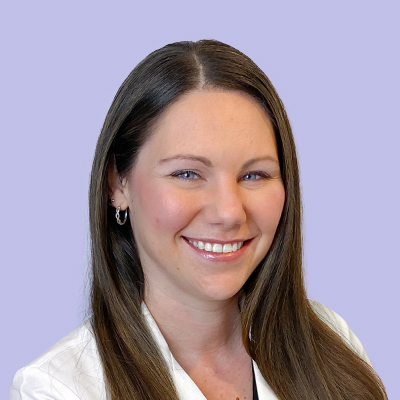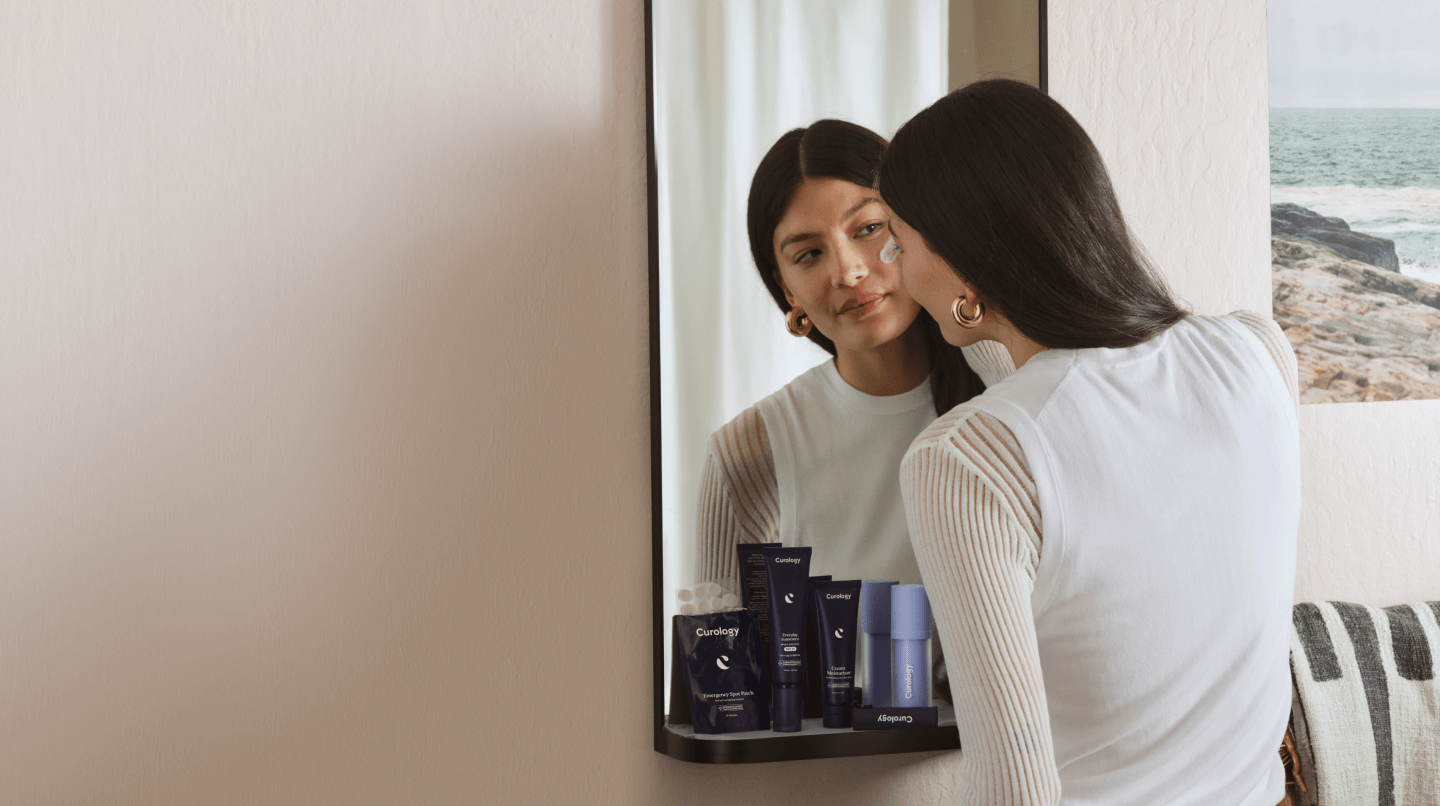How it works:
Share your skin goals and snap selfies
Your dermatology provider prescribes your formula
Apply nightly for happy, healthy skin
How it works:
How it works:
Share your skin goals and snap selfies
Your dermatology provider prescribes your formula
Apply nightly for happy, healthy skin
How it works:
What causes age spots and how you can treat them
Age spots have nothing to do with your age. Good news: They’re harmless and also treatable.



Age spots are small, dark patches on the skin that gradually occur with time, hence their name. Getting them has less to do with your age and more with the amount of time you spend in the sun.
More specifically, age spots are a type of hyperpigmentation caused by extended exposure to ultraviolet (UV) light, whether from the sun or tanning beds. While they’re more common among people 40 and older, anyone can get them. Their color can range from light brown to black, and they’re most commonly found on areas of the body that are often exposed to the sun, like the hands and face.
Like fine lines, age spots are harmless and don’t require treatment, but there are things you can do to reduce their appearance (if you’d like) or help prevent them altogether. Here we’ll tell you everything you need to know.
What causes age spots?
Also known as sun spots (arguably a more fitting name), liver spots, or solar lentigines, age spots are caused by excess deposition of melanin, the pigment that gives skin its color. Melanin is produced by cells in the skin called melanocytes, which produce more melanin when exposed to ultraviolet light (be it from the sun or a tanning bed). The extra melanin makes age spots appear darker than the surrounding skin.
Age spots are harmless and don't require treatment. However, age spots can sometimes be mistaken for more severe conditions such as skin cancer. If you have any concerns about dark spots on your skin, don't hesitate to book an appointment with your dermatology provider.
Factors that contribute to age spots include:
Sun exposure: UV rays from the sun can damage the skin, causing it to produce more melanin. When melanin is produced in excess, age spots can form.
Aging: While aging itself doesn’t cause age spots, they’re considered one of the signs of aging. This can be attributed to the amount of cumulative time you spend in the sun, which gradually adds up over the years.
Different skin tones: Age spots can appear more prominent in people with lighter skin because they have less melanin.

What do age spots look like?
Age spots are characterized by several features, including the following:
Color: Age spots range from light brown to black and may darken after time in the sun.
Texture: Flat to the touch, age spots don't usually differ in texture compared to the rest of your skin.
Size and shape: Age spots can vary in size but are often small and most commonly oval or round.
Age spot treatment options
Got age spots and wondering what to do about them? Again, they’re harmless, and that means there’s no harm in leaving them be. Also, some age spots may fade on their own with time. But if you’re wondering how to remove age spots naturally, there’s not really a way to do so—other than preventing them from happening in the first place. That said, there are several ways you can treat them to help reduce their appearance. Here’s how:
Reduce sun exposure
If possible, stay out of the sun between 10 am and 2 pm, when its rays are most damaging. Always use a broad-spectrum sunscreen with SPF 30 or more, apply about 15 minutes before heading outdoors (even on cloudy days!), and reapply every two hours or right after swimming or sweating. Opt for clothing that keeps you covered, including a wide-brimmed hat and sunglasses.
Try topical treatments
There are a number of both prescription and over-the-counter treatment options available for age spots. We recommend speaking with your dermatology provider to determine which option is best for your skin. Products that contain these popular active ingredients can help fade those pesky dark marks:
Hydroquinone: This powerhouse skin-lightening agent reduces melanin synthesis in the skin.
Tretinoin: This prescription-strength retinoid (aka Retin-A) helps to improve the appearance of age spots by promoting skin cell turnover. A derivative of vitamin A, it’s a popular anti-aging ingredient on the market for fighting dark spots.
Niacinamide: A topical form of vitamin B3, this antioxidant fights age spots by limiting the amount of melanin that’s produced in the skin.
Kojic acid: Exfoliating kojic acid brightens the skin by reducing melanin production, which can fade age spots.
Azelaic acid: This naturally occurring compound works to reduce age spots by inhibiting the skin's production of melanin.
While many over-the-counter products for reducing the appearance of age spots exist, your dermatology provider may recommend prescription-strength ingredients or other types of treatment. Those might include:
Laser treatment and IPL
Laser treatment is a generally safe, efficient way to treat age spots with long-lasting results on different skin types. It works by targeting and destroying the melanin-producing cells that cause age spots. The light from the laser is absorbed by the pigment, causing the cells to heat up and break apart. This process damages the age spots so that they eventually fade away. Multiple treatments are typically necessary to achieve the desired results.
Chemical peels
Chemical peels are a popular treatment option for age spots, as they work to remove the damaged outer layer of skin. This helps expose new, healthy skin cells and helps to improve the overall appearance of age spots. Chemical peels can be performed at different depths (superficial, medium, or deep) depending on the patient’s concern, and recovery time varies based on the level of skin treated. Be sure to speak with a professional for detailed pre-treatment care instructions before scheduling!
Microdermabrasion
Microdermabrasion is a cosmetic procedure that uses a small, abrasive tool to buff away the top layer of skin. This can help to improve the appearance of age spots. Typically performed by a licensed esthetician or dermatology provider in a salon or spa setting, the procedure is relatively quick and painless, and there is no downtime afterward. Minor side effects can include some redness or dryness. In one study, 40% of patients who received microdermabrasion twice monthly for four months saw a complete reduction in age spots.
Aging is a-okay
Age spots are a natural part of the aging process caused by years of sun exposure and other environmental factors. While they can't be eliminated entirely, some treatments can help lighten their appearance, including prescription products, chemical peels, laser treatments, and more. We like to think of age spots as a sign of a long life full of memories and experiences—something to be grateful for!

Treat age spots with a custom skincare routine
Curology helps take the guesswork out of choosing skincare products that suit your needs. Signing up is easy. Just answer a few questions and snap some selfies to help us get to know your skin better.
Get your personalized skincare routine with Curology
Get your personalized skincare routine with Curology


If Curology is right for you, we’ll pair you with one of our in-house licensed dermatology providers, who will create a personalized prescription formula designed to meet your specific skincare goals. We’ll send you a dermatology provider-designed skincare routine that contains a mix of ingredients that are proven to fight age spots. The best part? Your first box is free* (just pay $5.45 plus tax to cover shipping and handling) and comes with any of our recommended skincare products at no extra cost.
FAQs
Also known as sun spots (arguably a more fitting name), liver spots, or solar lentigines, age spots are caused by excess deposition of melanin, the pigment that gives skin its color.
Age spots are characterized by several features, including the following:
Color: Age spots range from light brown to black and may darken after time in the sun.
Texture: Flat to the touch, age spots don't usually differ in texture compared to the rest of your skin.
Size and shape: Age spots can vary in size but are often small and most commonly oval or round.
P.S. We did the homework so you don’t have to:
Chan, B. Solar lentigo. DermNet NZ. (2014).
Praetorius, C., et al. (2014). Sun-induced freckling: ephelides and solar lentigines. Pigment cell & melanoma research. (2014).
Chan, B. Solar lentigo.DermNet NZ. Ibid.
Schwartz, C., et al. Hydroquinone. In StatPearls. StatPearls Publishing. (2022).
Baldwin, HE., et al. 40 years of topical tretinoin use in review. J Drugs Dermatol. (2013).
Hollinger, J. C., et al. Are Natural Ingredients Effective in the Management of Hyperpigmentation? A Systematic Review.The Journal of clinical and aesthetic dermatology. (2018).
Chaowattanapanit, S., et al.Postinflammatory hyperpigmentation: A comprehensive overview: Treatment options and prevention. Ibid.
Nazzaro-Porro M.Azelaic acid. Journal of the American Academy of Dermatology. (1987).
O'Connor, A. A., et al. Chemical peels: A review of current practice. The Australasian journal of dermatology. (2018).
American Academy of Dermatology. What Can Get Rid of Age Spots? (n.d.).
Kristen Jokela is a certified Family Nurse Practitioner at Curology. She obtained her Master of Science in Nursing at the University of South Florida in Tampa, FL.
* Subject to consultation. Subscription is required. Results may vary. Trial is 30 days.

Curology Team

Kristen Jokela, NP-C
Related Articles
The 5 best chemical exfoliators for glowing skinWhich tretinoin is right for you, according to Vogue? How to help stop a rash from spreading, according to skin experts How to treat atrophic scars: Here’s what you need to knowA simple guide to skincare for menPopular Articles
Ask Curology: Is my cold breaking me out?Slugging: The dermatologist-approved skincare hack going viral on TikTokTretinoin vs retinol: What’s the difference?How to create a self-care routine that actually sticksYour 2023 skincare horoscopeTry prescription skincare
Get routine essentials


Face what’s next with Future-ProofRx
Face what’s next with Future-ProofRx
- Skin texture
- Fine lines
- Wrinkles
- Dark spots
- Dullness
$29.95/month